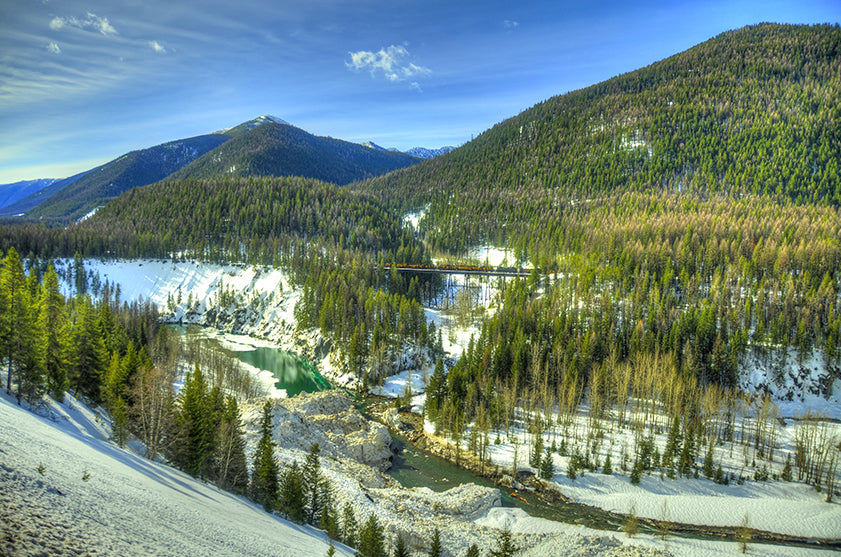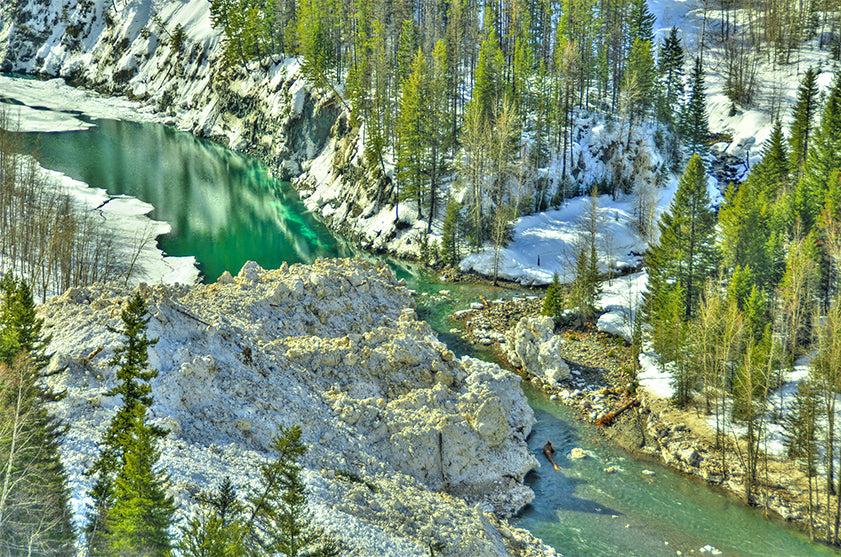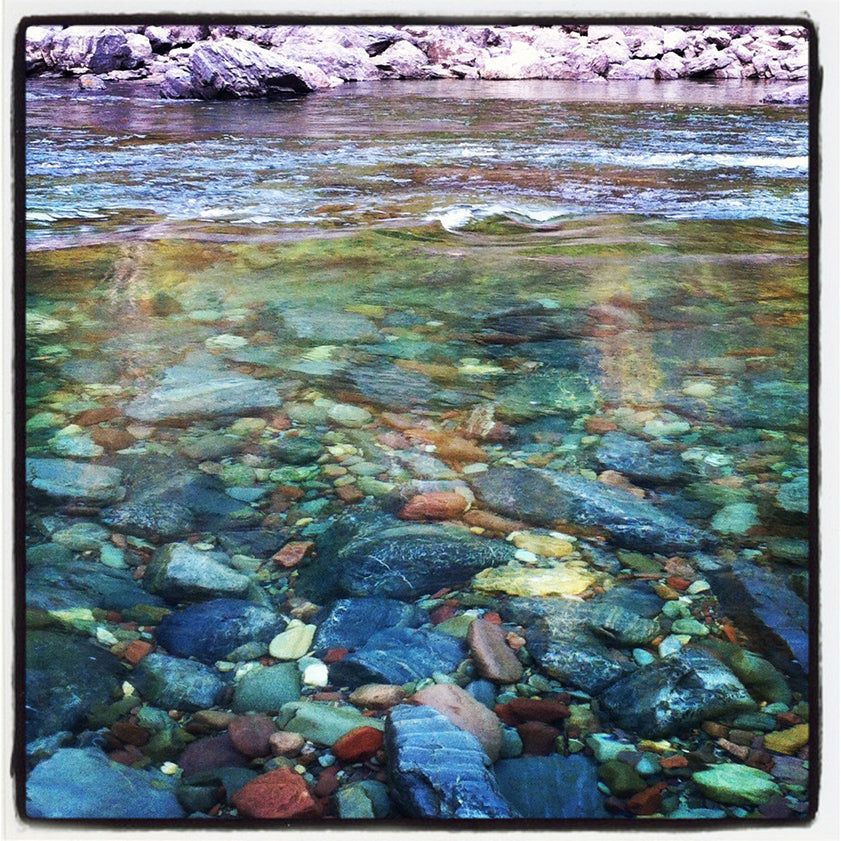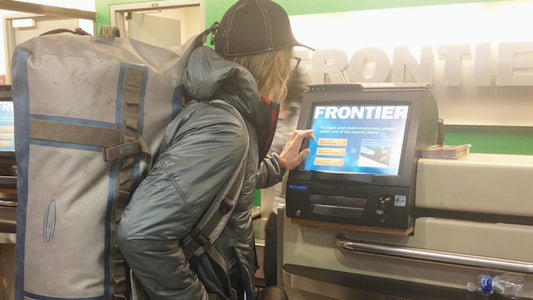When the railway hauling hundreds of thousands of barrels of oil “Prepares for the Worst”, it’s hard to ignore. And when the worst refers to what can happen to your favorite fishery, it’s impossible not to worry.
In every stage of life, I’ve lived near a railroad track. The haunting sounds of night trains with their short-blast-long-howl whistles and steady rumble have always been beautiful, grounding and comforting to me. I used to love watching gritty, graffiti-clad train cars pushing forward to get an important job done somewhere to my east or west. The history of the Great Northern Railway is fascinating, and as a river guide on the Middle Fork of the Flathead River, I’ve chronicled to guests how John F. Stevens found a route for the railway over Marias Pass and along the beautiful river in 1889.
But now, with the fracking boom in Eastern Montana and North Dakota, the haunting feeling I get when the train sounds its whistle isn’t comforting at all. Now, it’s a dark, foreboding moan with a connotation that keeps me up at night.
Just this year, hundreds of millions of barrels of crude oil from the Bakken fields will be hauled on the riverside railroad to refineries in Oregon and Washington, according to the Department of Transportation. The DOT released an October, 2013 BNSF report explaining that each oil car holds 700 barrels of crude, with each train carrying 120 cars. Currently one of these cars passes through John F. Stevens Canyon along the Middle Fork of the Flathead each day. Tasked with hauling much of this fossil fuel is an aged fleet of 78,000 tank cars prone to split open during accidents. Since it would take just one of these cars breaking into the river to cause unthinkable damage to the native westslope cutthroat and protected bull trout fishery, I have difficulty being calmed by BNSF’s affirmation that it is “a safety leader” and that its “incident rate is consistently lower than the industry average.” I can’t overlook that BNSF averages 14 accident-related hazmat releases each year. The company has had around 2,800 accident and non-accident hazmat incidents since 1995.
Last July, 47 people died in Quebec when an oil train derailed and blew up. In December, a BNSF oil train also exploded when it hit a derailed grain train in North Dakota. And oil train derailments in New Brunswick, Alberta and Alabama add to the list of caustic accident reports. Last month two BNSF freight trains carrying coal and automobiles jumped the tracks in two consecutive days here in Montana. This month, a BNSF freight train dumped empty coal cars in a derailment west of Whitefish, Montana. And last week two series of avalanches in John F. Stevens Canyon closed the tracks, one even covering a BNSF snow shed.
In a recent letter to U.S. Senator Heidi Heitkamp of North Dakota, the Federal Railroad Administration states that in North Dakota alone it found 13,141 defects in the tracks and issued 721 violations against BNSF. Think about this: that’s thousands of defects and hundreds of violations found during inspections of track that carries oil cars in just in one state! I’ve submitted a request for information on track inspections and defects in delicate John Stevens Canyon, and I hope elected officials in this area and media professionals will do the same, if they haven’t already. I know there has been some maintenance work completed on the track along the Middle Fork, but I’d like to learn more about whether BNSF is prioritizing attention to this stretch because of its delicate nature or if it’s just part of the general network maintenance queue.
In response to the increase in oil transportation, BNSF says it will beef up its tanker fleet with 5,000 oil cars equipped with ½-inch thick steel shields on either end of the tank to prevent them from cracking open. The company admits that the process of building these cars is backed up 24 months. The National Transportation Safety Board calls the current fleet “an unacceptable safety risk.” So, BNSF’s commitment to safety translates into a two year wait for new cars, none of which are guaranteed to be used on our stretch.
We’re expecting in coming weeks a BNSF document detailing an oil train derailment response plan, including instructions on how to use containment booms on the river. These precautions are important, but they hint that it’s not a matter of whether there will be a derailment at the river bordering Glacier National Park’s southern boundary, but when. Perhaps as incident response conversations are happening, there should more public discussion on incident prevention. For example, I’d like to hear that BNSF is prioritizing maintenance, upgraded equipment and extra care toward incident prevention on its route along the Middle Fork.
Fewer than ¼ of 1% of our nation’s rivers are protected by the National Wild & Scenic Rivers System. The Middle Fork is one of those special few. It seems that even with its federal designation as a Wild and Scenic River, our pristine home water is as vulnerable as ever.
My 11-year-old daughter, Ella, earned a blue ribbon at her school’s science fair last week for her project about oil cleanup methods. She experimented with tactics like containment booms, skimmers and dispersants. Ella was never able to remove all of the motor oil from her water pans. Afterward, we vowed to keep the project going by studying possible oil spill prevention strategies. Today, I’m reminded that what we’re faced with on the Middle Fork isn’t child’s play, and no blue ribbons will be handed out for demonstrating the cleanup of a toxic spill.
Last night, my nine-year-old daughter, Delaney, who is still afraid of the dark, asked me what I was afraid of. Nothing, I told her. “That’s not true,” Delaney said. “Daddy says you’re afraid that something bad might happen to the river.” Kids say the darnedest things.
--XXXX--
WHAT CAN WE DO?
Dave Skinner, a local newspaper columnist, recently said of the oil transportation issue, “The safe transportation of oil on our railroad system is a serious issue that won’t be wished away through fear. Handling oil cans properly requires, and deserves, a darn healthy dose of respect.”
As my youngest daughter Delaney pointed out, I am shamelessly inspired by fear as I respectfully encourage my friends and neighbors to ask questions about track maintenance and unacceptable oil cars, encourage legislators and media to ask these questions, learn how to be active in a constructive way and find ways to affect proper protection of the Middle Fork of the Flathead relative to oil transportation. I’ve listed some initial resources below for research, with whom to speak and how to get involved.
The point of this lengthy post is to impart some facts, but I’m also compelled to be part of the solution. So, we should learn as much as we can to trigger positive affirmation that BNSF and all agencies are doing all they can to prioritize attention to prevent an oil spill in the protected Middle Fork of the Flathead River. This might include calling for heightened track maintenance, confirmation that the projected new oil cans will be used on this route and a publicly-available list of additional specific measures BNSF is taking to keep a spill from happening.
A number of my friends are BNSF engineers and conductors, and I know they are smart, capable, hard-working professionals who care about their responsibility operating trains. Add their safety to the list of risks involved in the increase of oil trains lapping the Middle Fork of the Flathead.
• Associated Press--BNSF Plans to Upgrade Tanker Fleet After Accidents: http://hosted.ap.org/dynamic/stories/U/US_TRAIN_SAFETY?SITE=AP&SECTION=HOME&TEMPLATE=DEFAULT
• Letter from FRA to Sen. Heitkamp http://www.heitkamp.senate.gov/public/_cache/files/24a711a1-5989-4eab-82b9-1870e12a2e31/2-18-fra-letter.pdf
• Press Release from Sen. Heitkemp’s camp: http://www.heitkamp.senate.gov/public/index.cfm/2014/2/heitkamp-hears-from-railroad-administration-about-inspections-near-casselton-derailment-site
• BNSF cited for serious flaws in track before ND accident: http://www.startribune.com/business/246173781.html
• BNSF Crude-by-Rail Report, October, 2013: http://www.fra.dot.gov/eLib/details/L04814
• Associated Press--Rail Cars Used to Ship Crude Oil “Unacceptable”:
http://hosted.ap.org/dynamic/stories/U/US_OIL_TRAINS?SITE=AP&SECTION=HOME&TEMPLATE=DEFAULT
• Interagency Wild and Scenic Rivers Coordinating Council Members: http://www.rivers.gov/documents/council-members.pdf
• Great Northern Environmental Stewardship Area: http://www.gnsa.org/index.htm
• Burlington Northern Santa Fe Community Contacts: http://www.bnsf.com/communities/contact-us/
• Glacier National Park: http://www.nps.gov/glac/index.htm
• Flathead National Forest: http://www.fs.usda.gov/flathead
• Contact info for Montana’s U.S. Senators: http://www.senate.gov/general/contact_information/senators_cfm.cfm?State=MT
• Contact info for the Federal Railroad Administration: http://www.fra.dot.gov/Page/P0006
In the past 50 years, we have learned—all too slowly, I think—to prize and protect . . . precious gifts. Because we have, our own children and grandchildren will come to know and come to love the great forests and the wild rivers that we have protected and left to them . . . An unspoiled river is a very rare thing in this Nation today. Their flow and vitality have been harnessed by dams and too often they have been turned into open sewers by communities and by industries. It makes us all very fearful that all rivers will go this way unless somebody acts now to try to balance our river development. – President Lyndon Johnson on signing the Wild & Scenic Rivers Act, October 2, 1968.






